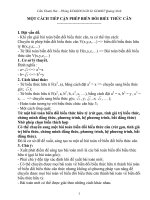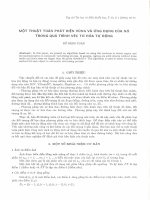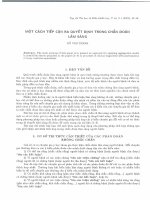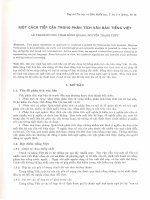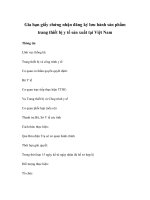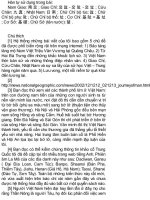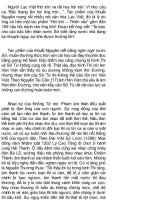Một cách tiếp cận với thiết bị Ubiquitous sử dụng T-engine tại Việt Nam
Bạn đang xem bản rút gọn của tài liệu. Xem và tải ngay bản đầy đủ của tài liệu tại đây (580.67 KB, 8 trang )
Science & Technology Development, Vol 14, No.K4- 2011
AN APPROACH OF UBIQUITOUS DEVICES USING T-ENGINE IN VIETNAM
Nguyen Hoa Hung, Nguyen Quang Huy, Dinh Duc Anh Vu
University of Technology, VNU-HCM
(Manuscript Received on April 27th 2011, Manuscript Revised November 25th 2011)
ABSTRACT: The 21st century is the era of Ubiquitous Computing where computing devices are
present everywhere in our lives. To satisfy the development of this tendency, many hardware platforms
have been proposed for developing Ubiquitous devices. Among them, T-Engine, an open standardized
development platform for embedded systems, is one of the most popular platforrms. It is nowadays
compatible with embedded equipments for a wide range of fields. In Vietnam, T-Engine has just been
introduced for 4 years. However, most of the ubiquitous applications using T-Engine are developed
restrictively based on the standard hardware of T-Engine. One issue that arises is the necessity of a
solution to expand T-Engine hardware and use it to control automatic systems to satisfy different types
of Ubiquitous devices. This research is to propose an approach to use T-Engine in the Ubiquitous
Devices that require the attachment of the additional hardware as well as the complicated control
mechanism with real time constraints. In this research, we proposed an expanding solution T-Engine
through the extension bus. Besides that, we consider the timing problems in bus transaction and
problems in real-time programming. A simple robot demonstration has also been designed and
implemented to prove the feasibility of our model. This approach will open up a new tendency of
developing complicated Ubiquitous devices using T-Engine in Vietnam.
1. INTRODUCTION
besides several application developments. For
the network communication, they are security
Ubiquitous computing is a post-desktop
model of human-computer interaction. The
typical characteristic to distinguish ubiquitous
computing with other model is that computing
takes place everywhere for everyone. The
computing devices will be embedded in the
environment. In this model, computer was kept
in the background presence.
There are three essential elements of
ubiquitous computing those are embedded
processor and embedded platform, wireless
communication, sensor. These three elements
also give rise to appropriate research trends
Trang 16
wireless networking, network media, etc; for
the sensor, we have developing different kinds
of sensor, wireless sensor networking; and
finally, they are developing low-power and
high-performance processor, developing and
utilizing standard platforms for ubiquitous
computing.
Each ubiquitous computing system has to
possess the following characteristics. Those are
the ability of remember events, ability to aware
the surrounding environment through various
kind of sensors. Especially, this system should
be responsive to other ubiquitous computing
TAẽP CH PHAT TRIEN KH&CN, TAP 14, SO K4 - 2011
systems. Therefore, it is required to have the
selected.
The
timing
problems
of
bus
ability to handle a number of complex tasks.
transaction will be considered in the second
In our research, we concentrate on the last
part. The third part discusses the main features
of the mentioned above research trends. That is
of T-Kernel, a real-time operating system of T-
utilizing standard platforms, particularly, it is a
Engine,
famous platform called T-Engine. We propose
programming on T-Kernel. The last part
a model for using this platform in ubiquitous
describes the robot demonstration using the
devices to fulfill the characteristic of ability to
proposed model.
and
some
problems
when
handle a number of complex tasks.
2.
T-Engine is an embedded-device standard
SOLUTION
OF
EXPANDING
T-
ENGINE HARDWARE
development platform specified by T-Engine
Forum, an industry organization consisting of
Three problems must be solved when
500 corporations. It supports various kinds of
expanding T-Engine hardware: accessing a
CPUs. It is equipped with T-Kernel which is a
separated ad��������������������������������������������������������������������������������������������������������������������������������������������������������������������������������������������������������������������������������������������������������������������������������������������������������������������������������������������������������������������������������������������������������������������������������������������������������������������������������������������������������������������������������������������������������������������������������������������������������������������������������������������������������������������������������������������������������������������������������������������������������������������������������������������������������������������������������������������������������������������������������������������������������������������������������������������������������������������������������������������������������������������������������������������������������������������������������������������������������������������������������������������������������������������������������������������������������������������������������������������������������������������������������������������������������������������������������������������������������������������������������������������������������������������������������������������������������������������������������������������������������������������������������������������������������������������������������������������������������������������������������������������������������������������������������������������������������������������������������������������������������������������������������������������������������������������������������������������������������������������������������������������������������������������������������������������������������������������������������������������������������������������������������������������������������������������������������������������������������������������������������������������������������������������������������������������������������������������������������������������������������������������������������������������������������������������������������������������������������������������������������������������������������������������������������������������������������������������������������������������������������������������������������������������������������������������������������������������������������������������������������������������������������������������������������������������������������������������������������������������������������������������������������������������������������������������������������������������������������������������������������������������������������������������������������������������������������������������������������������������������������������������������������������������������������������������������������������������������������������������������������������������������������������������������������������������������������������������������������������������������������������������������������������������������������������������������������������������������������������������������������������������������������������������������������������������������������������������������������������������������������������������������������������������������������������������������������������������������������������������������������������������������������������������������������������������������������������������������������������������������������������������������������������������������������������������������������������������������������������������������������������������������������������������������������������������������������������������������������������������������������������������������������������������������������������������������������������������������������������������������������������������������������������������������������������������������������������������������������������������������������������������������������������������������������������������������������������������������������������������������������������������������������������������������������������������������������������������������������������������������������������������������������������������������������������������������������������������������������������������������������������������������������������������������������������������������������������������������������������������������������������������������������������������������������������������������������������������������������������������������������������������������������������������������������������������������������������������������������������������������������������������������������������������������������������������������������������������������������������������������������������������������������������������������������������������������������������������������������������������������������������������������������������������������������������������������������������������������������������������������������������������������������������������������������������������������������������������������������������������������������������������������������������������������������������������������������������������������������������������������������������������������������������������������������������������������������������������������������������������������������������������������������������������������������������������������������������������������������������������������������������������������������������������������������������������������������������������������������������������������������������������������������������������������������������������������������������������������������������������������������������������������������������������������������������������������������������������������������������������������������������������������������������������������������������������������������������������������������������������������������������������������������������������������������������������������������������������������������������������������������������������������������������������������������������������������������������������������������������������������������������������������������������������������������������������������������������������������������������������������������������������������������������������������������������������������������������������������������������������������������������������������������������������������������������������������������������������������������������������������������������������������������������������������������������������������������������������������������������������������������������������������������������������������������������������������������������������������������������������������������������������������������������������������������������������������������������������������������������������������������������������������������������������������������������������������������������������������������������������������������������������������������������������������������������������������������������������������������������������������������������������������������������������������������������������������������������������������������������������������������������������������������������������������������������������������������������������������������������������������������������������������������������������������������������������������������������������������������������������������������������������������������������������������������������������������������������������������������������������������������������������������������������������������������������������������������������������������������������������������������������������������������������������������������������������������������������������������������������������������������������������������������������������������������������������������������������������������������������������������������������������������������stem management functions.
system.
control
functions,
task
T-Kernel scheduler is implemented based
5. DEMONSTRATION
on the preemptive priority-based scheduling
algorithm. The independent thread of execution
is defined as a task. Besides task, T-Kernel also
provides other types of object to manage the
synchronization
and
the
communication
between tasks. Those are: semaphore, eventflag,
mailbox,
mutex,
message
buffer,
There are some problems that need
considering when programming with T-Kernel.
The first problem is resource sharing, the
common problem of multitasking operating
system. Resource sharing is a function of task
The
application so we design a simple robot to
demonstrate our approach. It is implemented
using two T-Engines. The first T-Engine
controls the action of the robot while the
second T-Engine is in the remote control
device and controls the interaction with user.
rendezvous port.
priority.
A robot is a typical automatic system
higher
priority
task
has
precedence over other tasks when accessing
shared resources. However, if higher priority
tasks always take resources, lower priority
tasks will be in starvation state.
Robot can be controlled manually using remote
control device. Besides that, robot can run
automatically
and
solve
the
block-world
problem. The block-world problem is a typical
artificial intelligence problem. In this problem,
the robot has to recognize the order structure of
some blocks. In this demonstration, we
implement with four blocks. After recognizing
the structure, the robot will carry out the
planning process and find out the solution to
reorder the block to the expected structure.
The second problem is deadlock. Deadlock
happens when the following conditions are
present: mutual exclusion, no preemption, hold
and wait, or circular wait.
Robot includes several components such
as: run-motor card, lift-motor card, hold-motor
card, sensor modules and communication
Trang 21
Science & Technology Development, Vol 14, No.K4- 2011
modules. Those are connected to T-Engine
When it has finished doing a command, it
through the external bus interface.
sends an interrupt signal to T-Engine.
Figure 5 describes how a motor card can
Robot is controlled by six concurrent tasks.
communicate with T-Engine external bus
Four tasks are used to control motor cards. One
interface. The motor card acts like a peripheral
task controls the interaction with user. The
module of T-Engine. T-Engine controls its
other task is the main processing task. These
operation by setting the value of three registers.
tasks communicate with each other’s by a
message buffer.
Figure 5. Motor card block diagram.
6. CONCLUSION
complicated embedded platform. Besides that,
many issues have been introduced and partly
The research is the first step in developing
the controlling application of T-Engine as well
as Ubiquitous Devices. A connection model
has been proposed for expanding hardware of a
Trang 22
solved. This approach has opened up a new
tendency
of
developing
complicated
Ubiquitous devices using T-Engine in Vietnam.
TẠP CHÍ PHÁT TRIỂN KH&CN, TẬP 14, SỐ K4 - 2011
MỘT CÁCH TIẾP CẬN VỚI THIẾT BỊ UBIQUITOUS SỬ DỤNG T-ENGINE
TẠI VIỆT NAM
Nguyễn Hồ Hưng, Nguyễn Quang Huy, ðinh ðức Anh Vũ
Trường ðại học Bách khoa, ðHQG-HCM
TĨM TẮT: Thế kỷ 21 là kỷ ngun của Ubiquitous Computing trong đó các thiết bị tính tốn
xuất hiện ở khắp mọi nơi trong đời sống của chúng ta. ðể đáp ứng sự phát triển của xu hướng này,
nhiều nền tảng phần cứng đã được đề xuất để phát triển các thiết bị Ubiquitous. Trong số đó, T-Engine,
một nền tảng chuẩn hố mở cho hệ thống nhúng, là một trong những nền tảng phổ biến. Nó thích hợp
để phát triển những thiết bị nhúng ở nhiều lĩnh vực khác nhau. Ở Việt Nam, T-Engine được giới thiệu
cách đây 4 năm. Tuy nhiên, hầu hết các ứng dụng trên T-Engine chỉ hạn chế ở phần cứng chuẩn. Một
vấn đề nảy sinh đó là sự cần thiết phải có một giải pháp để mở rộng T-Engine và sử dụng để điều khiển
các hệ thống tự động để đáp ứng các u cầu khác nhau của một hệ thiết bị Ubiquitous. Nghiên cứu này
đề xuất một cách tiếp cận sử dụng T-Engine cho thiết bị Ubiquitous đòi hỏi có thêm các thiết bị phần
cứng và u cầu về điều khiển phức tạp với các ràng buộc về thời gian thực. Chúng tơi đề xuất giải
pháp mở rộng T-Engine thơng qua extension bus. Bên cạnh đó, vấn đề timing trong giao tiếp bus và lập
trình thời gian thực cũng được xem xét. Một mơ hình robot đơn giản để minh hoạ tính khả thi của
nghiên cứu được hiện thực. Cách tiếp cận này sẽ mở ra một hướng mới trong phát triển các thiết bị
Ubiquitous dùng T-Engine ở Việt Nam.
trúc phát triển tiêu chuẩn mở cho các
REFERENCES
hệ thống nhúng thời gian thực, Hội
[1] Qing Li, Carolyn Yao, Real-Time
Concepts
for
Embedded
Systems,
A.
Laplante,
Real-Time
Systems Design and Analysis, An
Engineer's Handbook, IEEE Press,
[3] Elaine Rich, Kevin Knight, Artificial
McGraw-Hill
User’s
manual,
T-Engine
forum
reference document (2002).
[6] T-Kernel
specification,
T-Engine
forum reference document (2002).
Piscataway (1993).
Intelligence,
Bách Khoa lần 9 (2005).
[5] SH7760 T-Engine Development Kit
CMP book (2003).
[2] Phillip
nghị khoa học cơng nghệ trường ðH
Higher
Education (1990).
[4] Nguyen Minh Phong, Vu Tuan Thanh,
Pham Tuong Hai, T-Engine - Kiến
[7] T-Engine/SH7760 Development Kit
Device
Driver
Manual,
T-Engine
forum reference document (2002).
[8] T-Engine
Forum
website
www.t-
engine.org
Trang 23
